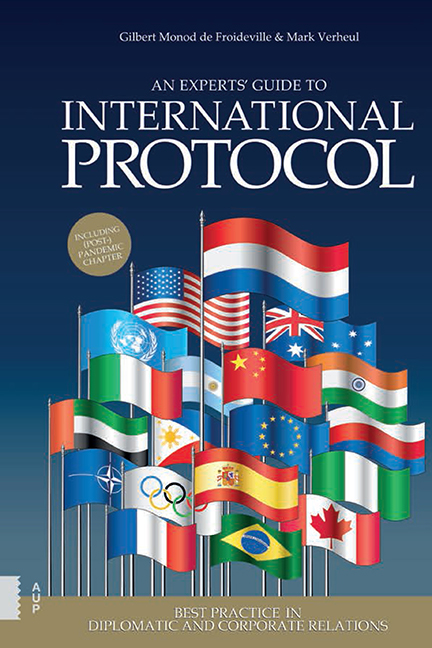Book contents
- Frontmatter
- Contents
- Preface to the original edition by His Royal Highness Prince Carlos de Bourbon de Parme
- Prologue
- Acknowledgements
- 1 International Protocol
- 2 Precedence
- 3 Seating Arrangements and Order of Processions
- 4 Flag Protocol
- 5 Invitations and Dress Codes
- 6 Gifts and Honours
- 7 Ceremonies
- 8 The Protocol Officer
- 9 Guest and Host
- 10 Protocol and Stakeholder Engagement During and after the COVID-19 Pandemic
- Authors’ Biographies
- Bibliography
- Websites
- Illustrations and Photographs
- Index
2 - Precedence
Published online by Cambridge University Press: 27 May 2021
- Frontmatter
- Contents
- Preface to the original edition by His Royal Highness Prince Carlos de Bourbon de Parme
- Prologue
- Acknowledgements
- 1 International Protocol
- 2 Precedence
- 3 Seating Arrangements and Order of Processions
- 4 Flag Protocol
- 5 Invitations and Dress Codes
- 6 Gifts and Honours
- 7 Ceremonies
- 8 The Protocol Officer
- 9 Guest and Host
- 10 Protocol and Stakeholder Engagement During and after the COVID-19 Pandemic
- Authors’ Biographies
- Bibliography
- Websites
- Illustrations and Photographs
- Index
Summary
Introduction and history
The most essential principle of international protocol is the showing of respect and acknowledgement of status, order, and hierarchy of functionaries and the authorities they represent. These rules of precedence are called prèsèance in French, a term that is used widely in the diplomatic world. For centuries, the power and wealth of a country, a dukedom, or a city determined the positions of their representatives. It is in this way that the Knights of the Golden Fleece, together with Philip the Good, Duke of Burgundy, held their ninth chapter meeting in The Hague, in 1456. In the Grote Kerk (Great Church), coats of arms were hung from the pillars above the seating places of every knight, and the quality of placement was determined by their wealth and status; the greater their wealth and status, the closer they were seated to Philip the Good. It goes without saying that over time, this led to uncomfortable or even violent situations, where one knight felt that his status was higher than another's and vice versa. In short, such a subjective way of determining the status of individuals was not ideal. In 1814 and 1815, in the aftermath of the Napoleonic Wars, the Congress of Vienna, under the leadership of the victorious powers Prussia, Austria, Russia, and Great Britain, was held to reconstruct the political and institutional order in Europe. During the congress, the Commission for Precedence According to Protocol borrowed from the notion of equality that had already been proclaimed twenty-five years earlier during the French Revolution in the second word of the motto Libertè, Égalitè, Fraternitè. On 19 March 1815, after meeting four times since December 1814, the commission decided that precedence could only be given to diplomats on the basis of their accreditation date, the date that the diplomat in question had presented his credentials to the receiving head of state. In other words, the more years of service in a country, the higher one's place on the order of precedence. Under this system, the longest-serving ambassador also acts as doyen (dean) of the diplomatic corps, allies or great powers are not given special status or privileges, and the papal legate, or nuncio, is given absolute priority. A nuncio is the ambassador from the Holy See to a government who advocates for the members of the Catholic Church in their host country.
- Type
- Chapter
- Information
- An Experts' Guide to International ProtocolBest Practices in Diplomatic and Corporate Relations, pp. 41 - 58Publisher: Amsterdam University PressPrint publication year: 2021



